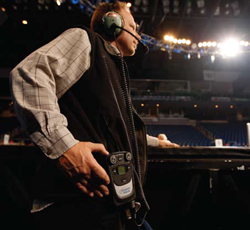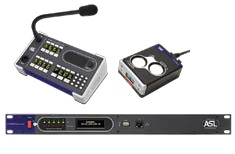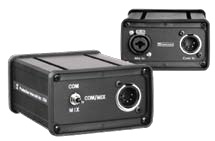
IP-Based (Virtual)
One of the most exciting recent developments is IP-based intercom, allowing virtual panels on laptop and desktop computers, and the ability to seamlessly link production personnel locally via the LAN and remotely via the Internet into the event communications.
Any combination of party-line and point-to-point communications can be established at these multi-channel virtual stations.
Each user can configure the station’s “buttons” in a preferred order, and choose talk/listen or listen-only channels. The “ad hoc” ability to add channels, reconfigure, or set up new conferences or point-to-point communications on the fly add to the versatility of this technology.
Because it is computer-based, text messages can also be sent – for example, to suggest setting up a quick point-to-point private discussion.

With interfacing, the IP-based intercom can connect with any other type of intercom system, such as analog or digital party-line, digital matrix, or wireless intercom. An existing facility’s communications network can be expanded or linked to another in a remote location.
Program audio can also be introduced and distributed, and paging and other audio outputs can be accomplished.
IP-based intercom systems are scalable, from a handful to hundreds of users. Audio CODECs provide highquality, intelligible audio and program, and encryption is used to keep the communications private.
Wireless Intercom
Wireless intercom systems consist of full-duplex beltpacks (able to converse two ways) and a base station (the common link among them and a connection nexus to wired intercom systems or other audio systems). Standard intercom headsets are typically used with wireless beltpacks.
These systems traditionally were analog and operated in the UHF television bands, just like wireless microphones.
The newer wireless intercoms operate in the 1.9 GHz DECT band or the 2.4 GHz WiFi band. These systems are digital, and often transmit over a narrower bandwidth, so they can offer more wireless beltpacks in a given production, less chance of interference with the other wireless devices, and much greater programmability and routing possibilities.

Some of these systems can even support point-to-point as well as party-line communications – and two-channel wireless beltpacks have become the norm.
In most applications, the wireless intercom is an extension of the wired system, used by those who require mobility for safety or convenience. However, the new digital systems are flexible and robust, able to support dozens of users, and thereby have become capable of being the main production intercom in a venue.
Interfacing
Intercom systems are rarely used in isolation; they are the communications and coordination systems behind a production that often includes other audio and video systems. So interfaces must be used to match the audio levels, impedance and operating characteristics of these different communications devices.
Most intercom providers have interfaces available as either stand-alone or integrated components in their systems.
Looking To the Future
The familiar party-line beltpack is likely to be with us for a good while yet; it’s cost-effective, simple to use, and gets the basic job done. But for those events that require complex, flexible, and expandable communications – and the ability to make changes on the fly – the new production intercom tools can bring together virtual production teams, allow more interactive communications, and require fewer dedicated cable runs.
Imagine the day when you come into the venue with your audio processing and production communications center under your arm on your laptop or tablet PC…
Gary Parks has previously served as marketing manager and wireless product manager for Clear-Com Intercom Systems, and has also worked with loudspeaker and wireless product management at Electro-Voice, in addition to serving as a technical writer at Meyer Sound. He is currently with EDX Wireless and is also a freelance writer.
